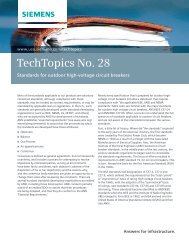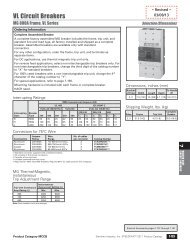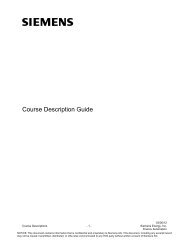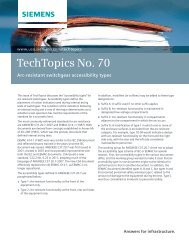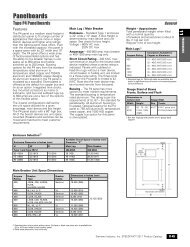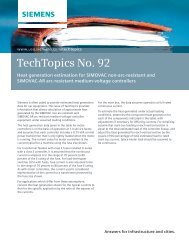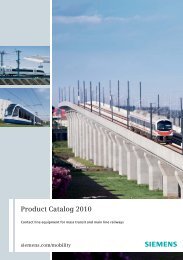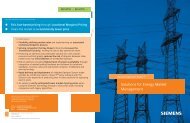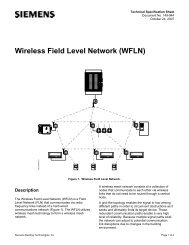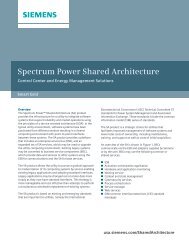TechTopics No. 33 - Siemens
TechTopics No. 33 - Siemens
TechTopics No. 33 - Siemens
Create successful ePaper yourself
Turn your PDF publications into a flip-book with our unique Google optimized e-Paper software.
The nearby enclosure elements may be smooth (a steelpanel) or may have protruding sharp edges (the flange of aformed panel or structural support). Conductors may run inparallel, or may cross each other at an angle. Conductorjoints and their protruding hardware also affect thedielectric performance. The profile of the conductor is alsovery significant, and is in fact why bus bars in mediumvoltageequipment are almost always full-round-edge bars.Square-edged bus bars must be used with care as the sharpcorners require greater clearance to achieve the samedielectric performance. Sharp corners result in higherdielectric stress than that with rounded edges.As if this were not sufficiently complicated, add thecomplication of insulated conductors and uninsulatedconductors. Even in metal-clad switchgear, there arenumerous elements of the equipment where conductivematerials are not insulated, such as at primary disconnects,on voltage or control power transformers, at the vacuuminterrupter of circuit breakers and other areas. Insulation isused to decrease the likelihood of dielectric failures as wellas to allow for a reduction in the size of switchgearstructures. In areas where the conductors are insulated, thespace between conductors or to ground can be much lowerthan would be possible with uninsulated conductors.The great variety of dielectric conditions inside theswitchgear or controller leads to the conclusion that nosingle clearance distance between conductors, or betweenconductors and ground, gives assurance that the equipmentwill meet the dielectric performance required by thestandards. The only valid way to have confidence in thedesign of the equipment is to subject it to the dielectric testsrequired by the standards.Each manufacturer has developed “rules” that themanufacturer uses when designing special configurationsnot part of the standard product. Such specialconfigurations may be associated with unusual incoming oroutgoing power connections (such as a large number ofpower cables per phase), special connections to adjacentequipment (such as power transformers or existingswitchgear), or unusual sections such as utility revenuemetering sections. The manufacturer has validated these“rules” during design dielectric tests of previous equipment,and uses them to create special arrangements to satisfy theever-changing requests of users. Since these “rules” havebeen validated during previous design tests, it is notnecessary to conduct new design dielectric tests each time aspecial arrangement is created.The standards also specify that dielectric ratings apply understandard conditions (temperature = 20 C°, pressure =101.3 kPa [14.7 psi], absolute humidity 11 g/m 3 ). Of course,standard conditions seldom if ever occur during testing.Therefore, the required voltages during testing must becorrected to adjust them to match the actual test conditionsand equate them to the performance at standard conditions.The requirements of the standards are intended to producetest conditions and parameters that are repeatable and areless likely to be affected by the choice of a particular testlaboratory.During dielectric testing, the equipment, conductors andinsulating members must be clean and uncontaminated.The result is that the tests demonstrate the performanceunder “ideal” (and repeatable) conditions, and performancein the installation site will not match the values obtainedduring design tests.Various standards and application guides recognize this, andspecify that a “protection margin” be used in insulationcoordination studies. This attempts to reconcile the rateddielectric values to the actual capabilities of the equipmentin real installations, where the insulation may be degradedby age, atmospheric conditions that are not “ideal”, theequipment and the insulating surfaces that are not clean,and other factors. Some documents suggest a protectionmargin of 15 percent, but the guide for application of metaloxidesurge arresters, IEEE C62.22, indicates factors from 15percent to 30 percent depending on application, the mostcommon value mentioned being 20 percent.Some readers may ask about the clearance requirements inthe IEEE C57 series of standards, such as C57.12.00 (powertransformers) or C57.19.01 (transformer bushings) orsimilar standards. These standards state required clearancesfor conductors exposed to the weather, such as bushings onpower transformers. Therefore, these applications involveexposure to rain, snow, and other influences. Accordingly,these standards not only specify dielectric tests levels butalso specify minimum clearances with due consideration tothe environmental effects.Conversely, the environment of conductors inside metalenclosedor metal-clad switchgear, or inside mediumvoltagemotor control centers, is treated as an indoorenvironment not subject to rain or snow inside theenclosure. This is the reason that standards for conductorsexposed to the weather do not apply to conductors insidemetal enclosures.The information provided in this document contains merely generaldescriptions or characteristics of performance which in case of actualuse do not always apply as described or which may change as a result offurther development of the products. An obligation to provide therespective characteristics shall only exist if expressly agreed in the termsof contract.All product designations may be trademarks or product names of<strong>Siemens</strong> AG or supplier companies whose use by third parties for theirown purposes could violate the rights of the owners.<strong>Siemens</strong> Industry, Inc.7000 <strong>Siemens</strong> RoadWendell, NC 27591Subject to change without prior notice.Order <strong>No</strong>.: IC1000-F320-A139-X-4A00All rights reserved.© 2012 <strong>Siemens</strong> Industry, Inc.For more information, contact: +1 (800) 347-6659www.usa.siemens.com/techtopics2




